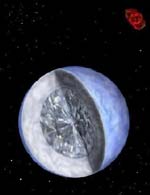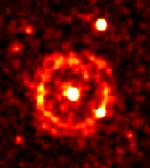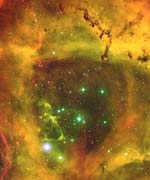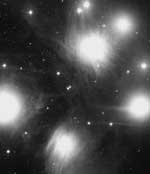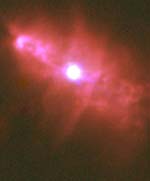
Image credit: John Rowe
The search for Earthlike planets begins with the search for Sunlike stars. At the top of the list is a reasonably nearby star called 37 Gem; located in the Gemini constellation. Astronomer Maggie Turnbull was asked to make a short list of thirty candidate stars that closely matched our own Sun out of a total list 2,350 stars which are within one hundred light years from us. This short list, including 37 Gem will be used by the Terrestrial Planet Finder mission, which will search for habitable planets by looking for the visible light of oxygen or water in an Earthlike planet – a sure sign of life.
The thirty-seventh most westerly star in the constellation, Gemini, is a yellow-orange star like our own sun. The star is called 37 Geminorum, but for astrophysicist Margaret Turnbull, the star is special because it offers a case study for considering what might qualify as a good candidate for harboring habitable planets.
In building her list of stars that might support planets with liquid water and oxygen, she has to exclude suns that are extreme: either too young or too old, that rotate too fast, or that are variable enough in brightness to cause climatic chaos on any nearby world.
At a distance of 56.3 light-years away, the star 37 Gem has yet to show tell-tale signs of having such planets, or any planets–but future NASA and European telescopes are looking to target stars just like 37 Gem since they might share some of the same properties that made our own solar system habitable. More than 100 extrasolar planets have been found so far using ground-based telescopes, and estimates for the total such planets in our galaxy may total in the billions of candidate worlds.
Working from the University of Arizona in Tucson, Maggie Turnbull was asked to make a short list of thirty star candidates that most closely resembled other suns capable of supporting the conditions for life to flourish. Starting her search among stars less than one hundred light-years away yielded about 2,350 stars to consider further.
Turnbull recently presented her results to a group of scientists from NASA’s space-telescope project, the Terrestrial Planet Finder (TPF), which will search for habitable planets by using visible light with the “signature” of water and/or oxygen from an Earth-type planet. After TPF’s scheduled launch around 2013, will follow the European Darwin project involving six space telescopes.
The stellar list was pared down from an even larger list (17,129 stars within 450 light-years, or 140 parsecs), which Turnbull and adviser Jill Tarter of the SETI Institute first published in Astrophysical Journal. The list became known as the Catalog of Nearby Habitable Stellar Systems (or HabCat ). Their article published in August, entitled “Target Selection for SETI: I. A Catalog of Nearby Habitable Stellar Systems,” expanded previous candidate lists by nearly ten-fold, or an order-of-magnitude.
To support complex life, a candidate star must be the right color, brightness, and age. If it is a middle-aged star like our own, it will have burned through enough fusionable light elements to produce heavier metals like iron, but not so old that it is collapsing or so young that life is only a distant future prospect. Based on what fragments we know about how complex life appeared on Earth, Turnbull’s search aims to find the ‘Goldilocks’ of stars that seems ‘just right’.
So why 37 Gem?
37 Geminorum lies in the northwest part of constellation Gemini , named after the Twins. For amateur astronomers with a good backyard telescope, 37 Gem is visible. In Greek mythology, the Gemini twins sailed with Jason in the quest for the Golden Fleece; during a storm, the twins helped save their ship ARGO from sinking, and so the constellation became much valued by sailors.
Most stars like Gem 37 are grouped into a small number of spectral classes, based roughly on the color of light they emit. Called the Henry Draper Catalog, the star compendium lists spectral classes in seven broad categories, from the hottest to the coolest stars. These types are designated, in order of decreasing temperature, by the letters O, B, A, F, G, K, and M. The nomenclature is rooted in long-obsolete ideas about stellar evolution, but the terminology remains. Our sun, classified on a finer scale as a typical ‘G2V’ dwarf, is approximately 4.5 billion years old. The candidate star, 37 Gem, is similarly middle-aged, but somewhat older by a billion years, at 5.5 billion years.
The spectra of G-type stars like our own (and 37 Gem) are dominated by certain chemical elements, as signaled by their characteristic spectral lines (or emissions). The elements of most current interest are metals, particularly for those star-signatures rich in iron, calcium, sodium, magnesium, and titanium. In astronomical terms, compared to our sun’s classification as a typical G2V dwarf, 37 Gem has a slightly hotter surface temperature. Thus Turnbull’s prime pick–37 Gem– is catalogued as a G0V dwarf–meaning it is also a yellow-orange main sequence dwarf star. Because G stars are characterized by the presence of these metallic lines and a weak hydrogen spectra, they share a common age, mass, and luminosity.
Otherwise, 37 Gem is close to our own solar twin, or a Gemini-like counterpart to the Sun: 1.1 times our sun’s mass, 1.03 times its diameter, and 1.25 times its luminosity.
Luminosities are “perhaps the most important information”, Turnbull told Astrobiology Magazine, “we use in determining the habitability of nearby stars” for complex life, because luminosity indicates which phase of life the star is in, and that in turn dictates how long the star will remain stable.
Astrobiology Magazine had the opportunity to talk with Maggie Turnbull at the Steward Observatory in Tucson about how to select stellar candidates for habitability.
Astrobiology Magazine (AM): Your recent survey began looking at around 100-light years distant from our Sun, and all stars inwards from that radius, correct? That was the visual sphere for starting the search?
Margaret Turnbull (MT): There are about 2,350 Hipparcos stars within 30 parsecs (90 light
years), the maximum distance for the Terrestrial Planet Finder (TPF) mission. There are about 5,000 total stars within that distance, but we are only looking at Hipparcos stars so my starting list is 2,350 stars long.
AM: Have you ever gotten hold of a backyard telescope to see 37 Gem?
MT: It should certainly be visible with a backyard telescope, but no, I haven’t looked at it with my own eyes! Because of the photometry (measuring its brightness) and spectroscopy (measuring its composition) I have looked at, I feel like I “know” it without ever having seen it.
However, there is more observing to be done for 37 Gem. For example, we do need to carry out high resolution infrared imaging of this star before we can say it should be a target–if we discover that there is a lot of debris floating around, we’ll have to take it off the list.
AM: Was the star, 37 Gem, much different from number two on the list of the thirty best candidates?
MT: Actually, the “best” stars are all very similar to one another, and in reality it doesn’t make much sense to try to rank them. 37 Gem happens to be one of the very nearest stars that also satisfies the engineering criteria, so at this time it looks like a very good candidate for the TPF search.
AM: Just out of curiousity, what star was officially number two on the list?
MT: When you are only going to look at thirty stars, they all better be “number one.” That is, every star we observe has to be of primary interest to the mission, because we have no time to waste. We are still in the process of precisely defining the primary mission goal.
If the goal is to look at range of spectral types, then the top stars may include very nearby K or M stars, but if the goal is to look at 30 of the most Sun-like stars, then stars like 18 Sco (a solar twin at 14 parsecs in the Constellation Scorpius), beta CVn (the “hound”), or 51 Peg (“Pegasus”, the flying horse) may end up being our best bets.
AM: Are there one or two pieces of missing data that would help the classification hone in better on star candidates?
MT: At this time, high-resolution infrared imaging is the missing piece of data that we definitely need. We need to know if these stars have dusty debris disks that would make it hard to detect planets orbiting there.
The Sun has a substantial amount of zodiacal dust because Jupiter is constantly stirring up the asteroid belt and as the asteroids collide they add dust to the Solar System.
A similar level of dust around other stars might not ruin our chances of seeing planets, but we’d certainly like to keep that to a minimum.
AM: What are your future plans for the stellar list in support of the Terrestrial Planet Finder and Darwin missions?
MT: I haven’t yet presented my ‘final’ list to the TPF science working group on Nov 18th and 19th at the US Naval Observatory, during a meeting with others who are creating their own lists.
I have already presented my methodology to the group, but now we will be meeting with engineers who will explain to us the constraints of the instrument and we will have to refine further the list to accommodate their criteria.
Their criteria will include things like: can’t have a companion star within several arcseconds even if the companion is not a concern for planet stability, because the extra light will contaminate the field of view; can’t look at stars fainter than about 6th magnitude; can only look at stars at least ~60 degrees away from the Sun during the whole year, etc.
AM: You published your first catalog of habitable stars in August of this year, and there is a part two to that classification. What are the main plans for Part II of the HabCat?
MT: Jill Tarter and I have recently submitted a second paper on the SETI target list which will appear in the Astrophysical Journal Supplements in December. This paper gives a list of old, high metallicity open clusters, the nearest 100 stars regardless of stellar type, and about 250,000 main sequence stars from the Tycho Catalogue, all of which will be observed by the Allen Telescope Array (ATA) whenever a HabCat star isn’t available for us to observe.
The primary ATA beam will be pointed by radio astronomers, and they will be making very high resolution maps of their own targets, while at the same time we will be observing HabCat stars (or stars from our lists in Paper 2) for SETI.
AM: Finally, are the missions, Kepler and TPF, planning the kinds of enhancements that would yield a detection of more Earth-sized planets, not just gas giants, for a given star in their surveys?
MT: Yes. Kepler will give us an indication of how common terrestrial planets are by watching thousands of sun-like stars for “transits”–events where the planet actually passes in front of the star it is orbiting and temporarily blocks a little of the star’s light.
Terrestrial Planet Finder will follow up on this by actually imaging planets orbiting the nearest stars, and telling us whether these planets have atmopheres by taking spectra.
We can look for water, oxygen, and carbon dioxide, and if we’re lucky we may even see some direct indications of life in the form of a vegetation signature or strong atmospheric disequilibrium, such as the simultaneous presence of oxygen and methane (due to the simultaneous presence of plants and methanogen bacteria on Earth).
What’s Next
Any mission to detect and spectroscopically characterize terrestrial planets around other stars must be designed so that it can detect diverse types of terrestrial planets with a useful outcome. Such missions are now under study–the Terrestrial Planet Finder (TPF), by NASA, and Darwin by ESA, the European Space Agency. The principal goal of TPF/Darwin is to provide data to the biologists and atmospheric chemists.
The TPF/Darwin concept hinges on the assumption that one can screen extrasolar planets for habitability spectroscopically. For such an assumption to be valid, we must answer the following questions. What makes a planet habitable and how can they be studied remotely? What are the diverse effects that biota might exert on the spectra of planetary atmospheres? What false positives might we expect? What are the evolutionary histories of atmospheres likely to be? And, especially, what are robust indicators of life?
TPF/Darwin must survey nearby stars for planetary systems that include terrestrial sized planets in their habitable zones (“Earth-like” planets). Through spectroscopy, TPF/Darwin must determine whether these planets have atmospheres and establish whether they are habitable.
The Kepler mission is also scheduled for launch into solar orbit in October 2006. Kepler is intended as a mission to determine the frequency of inner planets near the habitable zone of a wide range of stars. Kepler will simultaneously observe 100,000 stars in our galactic “neighborhood,” looking for Earth-sized or larger planets within the “habitable zone” around each star – the not-too-hot, not-too-cold zone where liquid water might exist on a planet.
To highlight the difficulty of detecting an Earth-sized planet orbiting a distant star, Kepler’s principal investigator, William Borucki of NASA Ames points out it would take 10,000 Earths to cover the Sun’s disk. One NASA estimate says Kepler should discover 50 terrestrial planets if most of those found are about Earth’s size, 185 planets if most are 30 percent larger than Earth and 640 if most are 2.2 times Earth’s size. In addition, Kepler is expected to find almost 900 giant planets close to their stars and about 30 giants orbiting at Jupiter-like distances from their parent stars.
Because most of the gas giant planets found so far orbit much closer to their stars than Jupiter does to the Sun, Borucki believes that during the four- to six-year mission, Kepler will find a large proportion of planets quite close to stars. If that proves true, he says, “We expect to find thousands of planets.”
Using present methods, astronomers today would find it very difficult to detect an Earth-sized planet around the star 37 Gem. Past analyses have however ruled out some choices. For instance, a giant planet like our own Jupiter or Saturn does not orbit around 37 Gem. These studies have suggested that giant planets of one-tenth to 10 times the mass of Jupiter do not exist close to 37 Gem (within 0.1 to four astronomical units, or one earth-sun distance, AUs, see also Cummings et al, 1999 ). Because of the challenges of finding dim planets near to much brighter stars, almost all of the extrasolar planets found so far are like our own Jupiter–massive, probably gaseous, and unlikely to harbor conditions for life owing to their close proximity to a parent star.
But conditions around 37 Gem might support smaller, inner planets like Venus or Earth. No one knows. Only future surveys will have the instrumentation capable of finding such Earth-like planets.
Models of stars like 37 Gem, do however, support the possible existence of at least one stable orbit for an Earth-like planet (with liquid water) centered around one earth-sun distance (1.12 AU). Such a presumed planet would orbit between the distances of Earth and Mars in our Solar System. This undiscovered planet, if it can be detected in future studies, would have a year that lasts more than 450 days, or an orbital period of around 1.3 Earth-years.
Since oxygen-generating life on Earth took about two billion years to take hold, stars much younger than this would likely not have had sufficient time for life to evolve towards any complex forms. Given the billions of years required for evolution of life on earth, scientists could question whether life would stand a chance in a shorter-lived solar system. Hotter, more massive stars have always been considered less likely to harbor life but not because they would be too hot. Planets could still enjoy temperate climates, just further out than Earth is from the Sun, and at orbits farther away from the its own parent star. The first problem of habitability is one of time, not temperature. Hotter stars tend to burn out faster — perhaps too fast for life to develop there.
Original Source: Astrobiology Magazine
